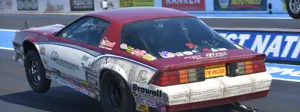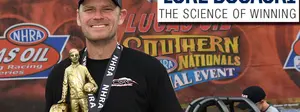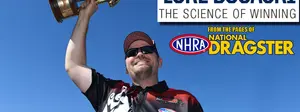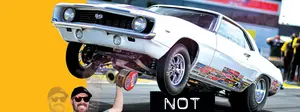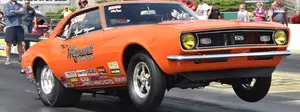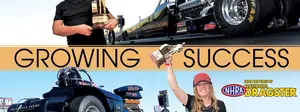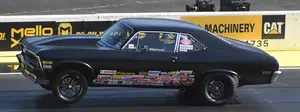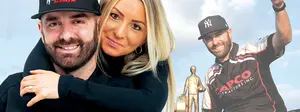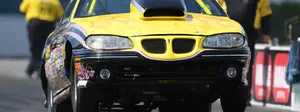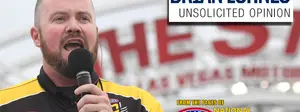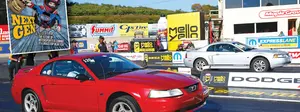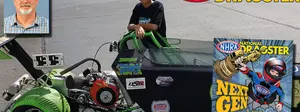

After a life-changing accident, Dom Lagana is on the comeback trail
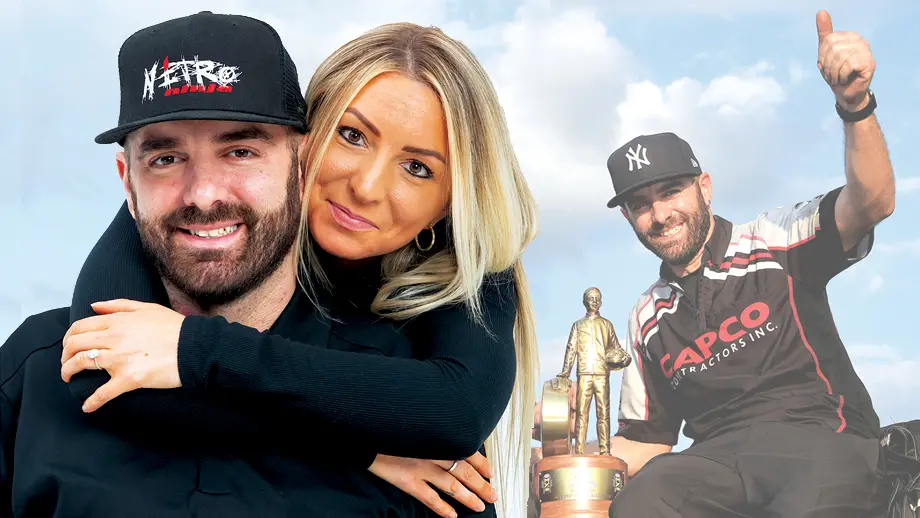

Among the list of nearly a dozen inspiring life rules inscribed onto the side of Dom Lagana’s Nitro Ninja Top Fuel dragster are these three: Life is built on second chances. Treasure your family and friends. Think positive, not negative.
In the wake of the highway accident last August that forever altered Lagana’s life, these insightful axioms became more than just guidelines. They became a roadmap to recovery.
The NHRA Drag Racing world, already tipped on its axis in early 2020 by the COVID-19 pandemic that brought racing to a halt for four months, seemed to spin even more crazily when Lagana, former Top Fuel driver Richie Crampton, and crewmember Jake Sanders were involved in the accident just hours after celebrating Steve Torrence’s victory at the Dodge NHRA Indy Nationals on Aug. 9.
While Crampton and Sanders escaped with relatively minor injuries, Lagana was knocked unconscious and momentarily trapped in the car, which caught fire. In addition to a severe brain injury, Lagana’s legs were so ravaged by the flames that they ultimately had to be amputated above the knee.
He spent months in the burn unit at Eskenazi Hospital in Indianapolis in a coma and clinging to life. Doctors sometimes painted a grim picture of him never waking up or, if he did, of having severe deficits from the diffuse axonal injury that occurs when the brain’s nerve fibers (axons) are sheared or torn when the brain shifts or rotates inside the skull.
Incredibly, nearly two months later, Lagana began stirring, then awakening. And when he finally woke, he was still good ol’ Dom. His family, including older brother Bobby and fiancée Sara, and his racing friends, some at his side throughout the ordeal and others praying for his recovery, rejoiced. The Ninja Rules were in full effect.
Some people called it a miracle. But it was really Lagana just doing what Laganas do. They survive. They persevere.
[ ]
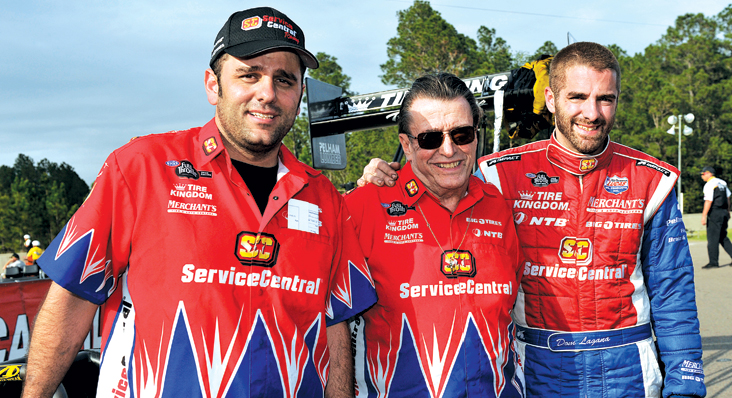
Dom and Bobby Lagana are loved and respected throughout the nitro pits and known for working on the dual Torrence Racing dragsters and for offering their help to many of their peers, but the New York Yankees-loving siblings learned their craft and the selfless giving principles from their Funny Car-racing father.
Bobby Lagana Sr. was as tough as he looked, with thick, muscled arms and the no-neck body of a fighter. He began racing around his New York home and ultimately fielded his own Funny Car, which he dubbed Twilight Zone. He was a low-on-bucks, big-in-heart favorite of East Coast fans.
Dom was born in 1985, a few years after his dad began running the Twilight Zone. He and brother Bobby, older by six and a half years, were “pretty much born at the racetrack and raised around nitro.” By age 6, Dom was cleaning oil pans and polishing wheels. By 13, he was servicing the engine’s bottom end. The family team didn’t have a lot of parts, and the ones they did have were largely hand-me-downs, but they made it work, mostly in match race and IHRA competition with occasional forays to NHRA national events, their Funny Car clinging to the back of a ramp truck like a 1970s throwback.
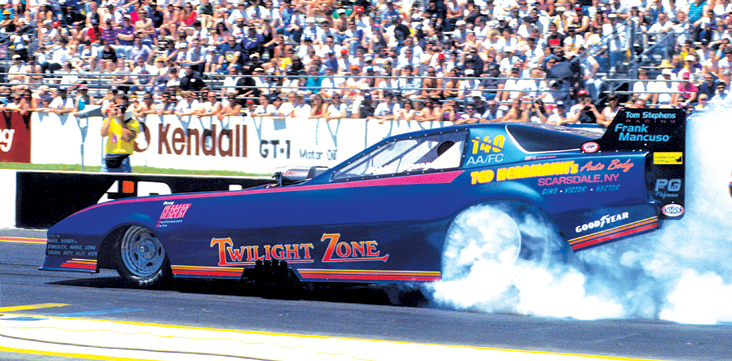
“We were always in survival mode and scraping by,” Lagana remembered. “Guys would give us their junk parts, and my dad would show us how to make them last longer. Dad raced because he loved drag racing. It was always just a hobby, but he always dreamed of making it big one day. We were fighting toward that goal, but he didn’t have to reach that goal to call it a success.
“He enjoyed bringing us out as a family, kind of like a vacation for us. We were always out there, and he wanted his cars to look good and perform to the best the parts would allow. He taught us to feel blessed by our friends and family and to enjoy the people you’re around, to enjoy racing for more than just the competition, to enjoy it for the camaraderie and friendship. Those are lessons that Bob and I have carried throughout our lives and are the backbone of those Ninja Rules on the car.”
When IHRA phased out Funny Cars, the Laganas got a dragster, but because they couldn’t afford a trailer, they simply strapped the dragster to the ramp truck with the front half protruding above the cab.
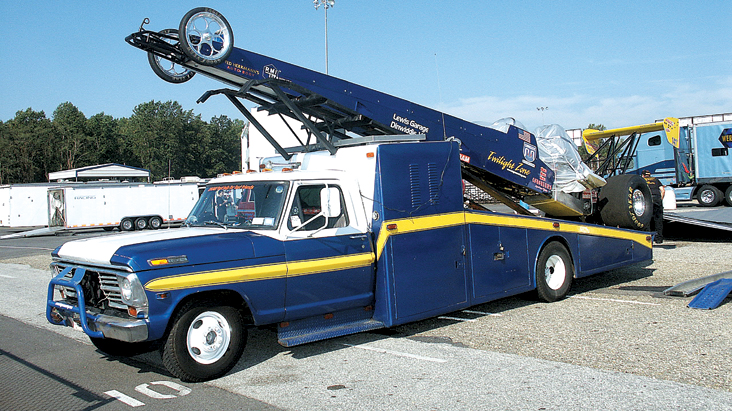
(Roger Richards photo)
“The front end hung over the sleeper; you could see the nose from inside the cab,” Lagana recalled with a laugh. “It looked like a circus, but it was his way of surviving.”
Bobby Jr. took over the wheel of the dragster full time in 1998 but experienced a bad crash in July when the throttle hung open and the car careened off the end of the track in Leicester, N.Y. The accident destroyed the car and severed several fingers (all but one of which doctors were able to reattach).
Bobby spent three weeks in the hospital recovering and 13-year-old Dom was by his side, a favor Bobby would repay many times over last year.
The team regrouped and eventually Dom and Bobby split the driving duties and were able to get sponsorship from companies like NTB and Big O Tires. Bobby reached the semifinals of the 2010 Gatornationals and Dom the final of the fall Las Vegas race later that year. Bobby Lagana Sr. died in 2013 of heart failure, and his boys decided it was time to take a break.
“As crazy as it is, we already knew the Torrences, and the opportunity was there to work on Billy’s car,” said Dom. “It was good therapy for us.”
[ ]
The Laganas began working for the Torrences in 2013 and have been there ever since. After years of scrimping and saving on parts, they got a chance to see how the other half lives.
“To be working for the Torrences, it was just like a fantasy,” said Lagana, “someplace we hoped maybe we could be one day but probably wasn’t going to happen, which is why Bob and I enjoy the position we’re in.”

Dom also branched out and began helping others, including aspiring nitro drivers like Ashley Sanford, Tripp Tatum, and Noah Stutz, who all got experience in the Nitro Ninja, which debuted in 2013. He flew to Sweden to help Anita Makela and gave her the guidance and parts to win two FIA championships. He drove for Australian businessman Santo Rapisarda, both on the NHRA circuit and at match races Down Under, and flew to New Zealand to help Tony Marsh’s team make the country’s first four-second and 300-mph runs.
“Racing has taken me places that have been unbelievable,” he reflected. “Sometimes I’d be getting off a plane or waiting at customs and thinking, ‘Man, I’m a long way from home,’ but it’s been a journey.”
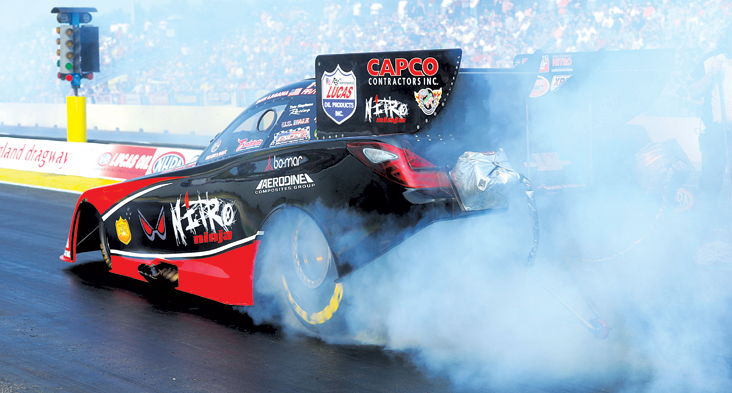
The journey even took him to a place he never thought he’d go: under the body of a Funny Car when he partnered with Aaron Brooks and John Stewart in 2015 to bring a Funny Car back to the Lagana family.
“I was so young when my dad had Funny Cars, so most of my racing life was with dragsters, but I always had that Funny Car guy inside of me,” he explained. “Driving the Funny Car was equal parts awesome and intimidating, but I got to run it in Englishtown and Epping, two of my dad’s favorite tracks, and even won a round at E-Town and ran 300 mph. I know my dad was watching and had that final satisfaction of going, ‘Ah, my boys finally got a Funny Car out there.’ ”
[ ]

Lagana doesn’t recall the details of the accident that forever changed his life. He just remembers the world slowly coming back into focus as he came out of his coma and dealing with the reality that he’d lost his legs in the accident.
“I was awake for two weeks, where I didn’t remember anything, but part of that was the medication I was taking. I wondered where the season was at, what was going on, and what did I miss. I had no idea how much time had passed.
“It was very tough to hear that I’d lost my legs, but I also was counting my blessings right away because it could have gone the other way very easily. I was grateful that my brain was healed and that I had the incredible support system with Sara and Bob.”
He also found out and was incredibly touched that Steve Torrence chose to run his Nitro Ninja body panels on his Capco dragster at the NHRA U.S. Nationals.
“Sara showed me the photos of the Ninja body on Steve’s car, that was just awesome,” he said, still smiling at the moment. “I still look at photos on my phone. When I’m having bad days, she’s always been there to pick me up. They also showed me photos of all the people wearing #LaganaStrong T-shirts and stickers on everyone’s car. Bob sent me one of Dougie’s [Kalitta] car with the sticker right on the cockpit, that meant a lot to me. It was very special.”
Lagana also drew strength from the people who reached out after suffering their own life trials: Darrell Gwynn, who was paralyzed in a racing accident; Pro Mod racer Dan Parker, who lost his eyesight in a racing crash; Top Alcohol Funny Car owner Jay Blake, who was blinded in an industrial accident; Reggie Showers, the Pro Stock Motorcycle rider who lost his legs as a teen but was able to ride and win the U.S. Nationals with prosthetic legs; and Kenny Logan, a friend of Torrence crew chief Richard Hogan and a double amputee after a 1970s racing crash.
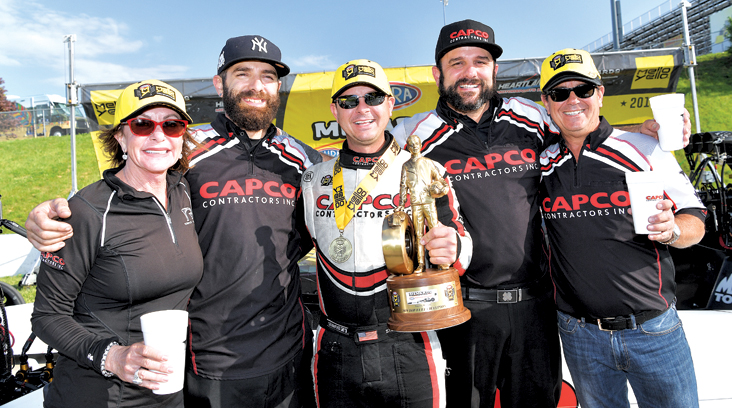
“All of that went a long way for the healing process,” he said. “I was able to watch some races on my iPad and see all of the support, how all of these people banded together and shared positive thoughts. We’ve always tried to lend a hand to people because that’s what our dad always taught us, and this reassured us that all of these years we weren’t just messing around, that we were making a difference in people’s lives.”
Just before his accident, Lagana had helped rewire and replumb the dragster of longtime friend Chris Karamesines so that the car would be right when granddaughter Krista made her licensing runs.
“Krista was licensing at St. Louis, and I FaceTimed Bob just to talk, and it turned out he was on the line while Krista was making one of her runs,” Lagana recalled. “It was perfect. I was on the starting line watching a dragster run, which is where I want to be. ‘Greek’ got on the call and was crying and happy to see me and grateful for what we’d done.”

Brother Bobby also counts their blessings for the incredible hospital staff who put up with their incessant questions and requests for options and information, all amidst the COVID-19 pandemic that made things even more challenging.
“We were raised with a great deal of faith, and to not fear the idea of death, which lets you have a different view of things,” Bobby said. “We told the doctors that we wanted to know every little thing, every change in his condition, every plan, every possibility. I think we showed them a new way to communicate with families.
“They were so great to us. I brought wind chimes into his room because we always have them in our pits, and even though there’s no wind in the room, the nurses would ring them for him when he was still in the coma. Anything to help. They were amazing.”
[ ]

Lagana spent 103 days in the hospital and was released home just before Thanksgiving to begin to rebuild his life. He’s already shopped for prosthetic legs and is back in the Torrence shop in Indy, where he and Sara and Bobby purchased a house to be close to his doctors. He wants to get better not just for himself but for all of those who supported him.
“I can’t imagine how tough it was on Bob to have this in the back of his mind while he was still trying to do his job on Steve’s car,” he said. “You realize that your family is going through it as much as you are. I felt bad for Sara, who picked up her life and moved from New York to Indy, for having to help me shower or cut up my meals, and that just drove me to become more independent. The Torrences – Steve, Kay, Billy – are like family to us, and all of the Capco crew are like brothers. Seeing them all and being back at work has been very therapeutic.
“I can’t wait to go back to the hospital and visit them because we became good friends. They were special people who took an interest in me not just as a patient but as a person and saved my life.
“Coping with my amputations, I knew life would be different, and there’s a lot of very hard work ahead of me learning how to walk again and have my balance, but I’m motivated to have the strength to get through it. I’m ready to tackle that challenge. If my body allows that, I’ll be in Gainesville. That’s my goal right now. Life is built on second chances, and I’m at peace with what happened. I just want to be able to walk again and try to get back to normalcy.
“And while I’m eternally grateful for people helping me, it’s going to be a better feeling that I can do things on my own. That’s the driving force. My therapists could tell I was very motivated and that I was pushing myself hard. I told them that’s all we know at the racetrack. Whatever is thrown your way, you push through it.
“The racer’s fight in me has come out, that never-give-up attitude. We are Lagana Strong and Lagana tough.”
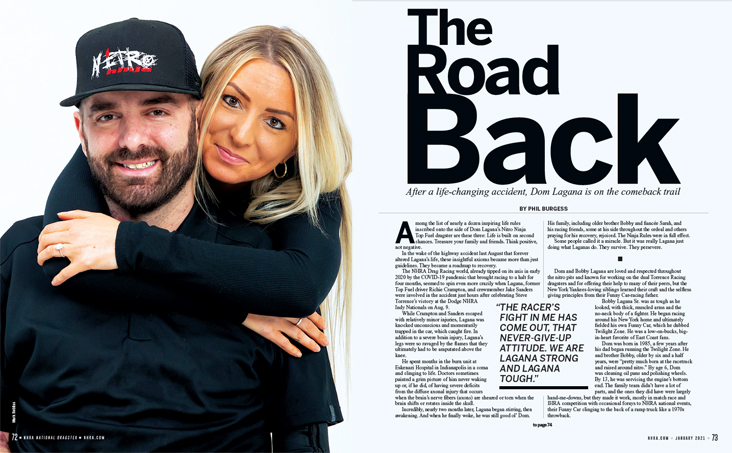
This article first appeared in the January issue of the all-new glossy NHRA National Dragster magazine. NHRA members get National Dragster for free. JOIN NOW!























